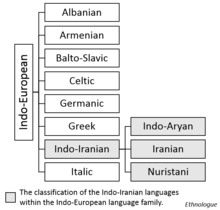Portal:Indo-Iranian languages and literature
The Indo-Iranian language group constitutes the easternmost extant branch of the Indo-European family of languages. It consists of three language groups: the Indo-Aryan, Iranian and Nuristani. The term Aryan languages is occasionally still used to refer to the Indo-Iranian languages.

General
[edit]- A Comparative Grammar of the Modern Aryan Languages of India(transcription project), by John Beames
Bengali
[edit]- See also Bengali Wikisource
Gujarati
[edit]- See also Gujarati Wikisource
Gujarati (ગુજરાતી Gujrātī?) is an Indo-Aryan language, and part of the greater Indo-European language family. It is derived from a language called Old Western Rajasthani (1100 - 1500 AD) which is the ancestor language of the modern Gujarati and Rajasthani languages. It is native to the Indian state of Gujarat, and is its chief language, as well as of the adjacent union territories of Daman and Diu and Dadra and Nagar Haveli.
- Hind Swaraj ("Freedom's Battle" or Indian Home Rule), 1908 by Mohandas K. Gandhi
- Unto This Last, 1908 by Mohandas K. Gandhi, translated by Valji Govindji Desai
Hindustani
[edit]
Standard Hindi
[edit]- See also the Hindi portal on central Wikisource
Standard Hindi, or more precisely Modern Standard Hindi, also known as Manak Hindi (Devanagari: मानक हिन्दी), High Hindi, Nagari Hindi, and Literary Hindi, is a standardized and sanskritised register of the Hindustani language derived from the Khariboli dialect of Delhi and Uttar Pradesh region. It is one of the 22 official languages of India and is used as the primary official language of the Republic of India.
- A Guide to Health, 1921 by Mohandas K. Gandhi, translated by A. Rama Iyer
Standard Urdu
[edit]- See also the Urdu portal on central Wikisource
Standard Urdu is another standard register of the Hindustani language that retains more of the Persian, Arabic and Chagatai vocabulary in Hindustani and written in the Perso-Arabic script. Is is the official language of Pakistan and an official language in five Indian states.
Pàli
[edit]- See also the Pali portal on central Wikisource
Pāli (also Pāḷi) is a Middle Indo-Aryan language (or prakrit) of the Indian subcontinent. It is best known as the language of many of the earliest extant Buddhist scriptures, as collected in the Pāḷi Canon or Tipitaka, and as the liturgical language of Theravada Buddhism.
- Dhammapada, translated by Friedrich Max Müller, a versified Buddhist scripture traditionally ascribed to the Buddha himself.
- Brahmajala Sutta, translated by T. W. Rhys Davids, the first of 34 suttas in the Digha Nikaya (the Long Discourses of the Buddha).
- Samannaphala Sutta ("The Fruit of Contemplative Life Discourse"), translated by T. W. Rhys Davids, the second of 34 suttas in the Digha Nikaya (the Long Discourses of the Buddha).
Persian
[edit]
- See also Persian Wikisource
Persian (local name: فارسی, Fārsi IPA: [fɒːɾˈsi], sometimes used in English) is an Iranian language within the Indo-Iranian branch of the Indo-European languages. It is widely spoken in Iran (and in the Iranian diaspora), Afghanistan (as Dari), Tajikistan (as Tajik), Pakistan (by Afghan immigrants), Uzbekistan and to some extent in Armenia, Iraq, Lebanon, Turkmenistan, Azerbaijan and Bahrain.
- The Rubaiyat of Omar Khayyam, 11th-12th century by Omar Khayyám
- The Alchemy of Happiness, shortly before 1105 by Abu Hamid al-Ghazālī, 1909 translation by Claud Field
- The Confessions of al-Ghazali, by Abu Hamid al-Ghazālī, translated by Claud Field
- Friendship and Sincerity, by Abu Hamid al-Ghazālī, 1921 translation by Syed Nawab Ali
- Human Freedom and Responsibility, by Abu Hamid al-Ghazālī, 1921 translation by Syed Nawab Ali
- The Love of God and Its Signs, by Abu Hamid al-Ghazālī, 1921 translation by Syed Nawab Ali
- Man’s Highest Happiness, by Abu Hamid al-Ghazālī, 1921 translation by Syed Nawab Ali
- The Nature of Love, by Abu Hamid al-Ghazālī, 1921 translation by Syed Nawab Ali
- The Nature of Man, by Abu Hamid al-Ghazālī, 1921 translation by Syed Nawab Ali
- Pride and Vanity, by Abu Hamid al-Ghazālī, 1921 translation by Syed Nawab Ali
- “Riza” Or Joyous Submission to His Will, by Abu Hamid al-Ghazālī, 1921 translation by Syed Nawab Ali
- The Unity of God, by Abu Hamid al-Ghazālī, 1921 translation by Syed Nawab Ali
- Anwari poem 12th century by Anwari, 1785 translation by William Kirkpatrick
Prakrit
[edit]Prakrit (also transliterated as Pracrit) (Sanskrit: prākṛta प्राकृत (from pra-kṛti प्रकृति)) is the name for a group of Middle Indic, Indo-Aryan languages, derived from Old Indic dialects. The word, derived from its Indian root "Parikrit", itself has a flexible definition, being defined sometimes as, "original, natural, artless, normal, ordinary, usual", or "vernacular", in contrast to the literary and religious orthodoxy of saṃskṛtā. Prakrit is foremost a native term, designating "vernaculars" as opposed to Sanskrit.
- Acaranga Sutra, 6th century BCE, 1884 translation by Hermann Jacobi
- Dravyasamgraha, 10th century by Ācārya Nemicandra, 1917 translation by Sarat Chandra Ghoshal
- Logassa, translated by Manish Modi
- Mangala Sutra, translated by Manish Modi
- Namotthunam, translated by Manish Modi
Sanskrit
[edit]- See also Sanskrit Wikisource
See also
[edit]- Portal:Dravidian languages and literature
- Bengali Wikisource
- Malayalam Wikisource
- Khowar portal on central Wikisource
- Urdu portal on central Wikisource